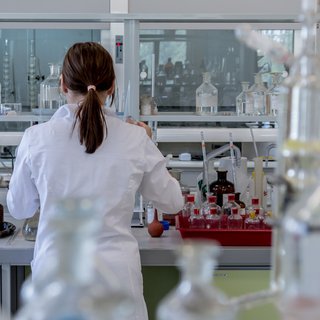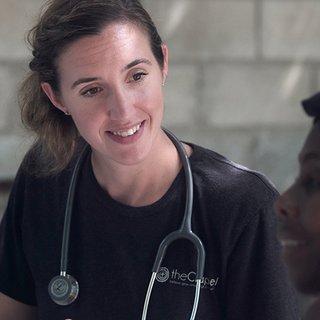Research impact on leukaemia
Many of the leading doctors in the 1960s and 1970s, who looked into finding cures for leukaemia, were either directly funded by us or played a crucial role on our scientific advisory board.

We helped them to set up research units, funded travel fellowships and international networking opportunities. All of this made sure that the UK was able to stay at the forefront of the global effort to beat leukaemia.
Studying chromosomes to improve treatments
Professor Lorna Secker-Walker was a pioneer in cytogenetics (the study of chromosomes) and with funding from us, in the 1990s established the UK Cancer Cytogenetics Group (UKCCG) which started to collect data on the chromosomes of all leukaemia patients entering UK clinical treatment trials. Her work led to a strong network of centres that conduct world-leading clinical genetics testing.
All the cytogenetics data of more than 30,000 patients, who were treated on UK leukaemia trials, are now available to researchers worldwide. They have already been used to make several crucial discoveries. For example, it was found that people with a chromosome abnormality called iAMP21 had a high risk of their disease returning.
Our research impact on different types of leukaemia:
The minimal residual disease test: one of the biggest cancer breakthroughs of the last 30 years
In the 1990s we funded two researchers who developed a very sensitive method for detecting cancer cells that are left behind in the blood or bone marrow after treatment. This method is called the minimal residual disease (MRD) test. This test is now used worldwide as the gold standard for assessing how someone has responded to their initial treatment and helps doctors to plan whether they should increase or decrease the intensity of subsequent treatment.
Understanding the causes of leukaemia
Epidemiology – the study of where and how often diseases occur and what causes them – is an area that we have invested in since the 1980s and in 1987 we established a new Centre for Clinical Epidemiology of Human Leukaemia and Related Diseases in Leeds.
In 1990, the results of the unit’s first five-year study were published which was the first study attempting to examine the distribution of cases of leukaemia, lymphoma and other blood cancers.
The MRD test for acute promyelocytic leukaemia (APL)
Acute promyelocytic leukaemia (APL) is a subtype of AML that is usually caused by two genes sticking together in an abnormal way. With funding from us, Professor David Grimwade at Kings College London used this discovery to develop an MRD test specifically for APL. This looked at the levels of cancerous cells with this change over time.
The test allows doctors to monitor how people respond to treatment, as well as any signs of relapse afterwards.
Improving the diagnosis and treatment of myeloproliferative neoplasms (MPNs)
We part-funded research led by Professor Anthony Green that has transformed the diagnosis and treatment of people with myeloproliferative neoplasms (MPNs). These conditions cause additional problems such as heart disease and blood clotting disorders, and can also develop into acute leukaemia. This means it is crucial to spot them early. However, they are difficult for doctors to diagnose because they are rare – the signs are subtle and the symptoms are similar to other diseases.
Testing for the JAK2 mutations is now firmly embedded in national and international guidelines to help doctors diagnose MPNs faster and more accurately.
Finding more effective CML drugs
Professor Richard Clark at the University of Liverpool conducted research into understanding why some people with Chronic myelogenous leukemia (CML) do not respond to imatinib. He found the channel that transports the drug into CML cells and found that the levels of this channel on the surface of CML cells could predict response to imatinib. He later showed that two other TKI drugs called nilotinib and dasatinib, were transported into cells without using this channel and could therefore be used in people where imatinib did not work.
Both drugs are now approved for CML in the UK.
Heading towards a cure for CML
Despite the huge success of the TKI drugs, people with CML still face a lifetime of having to take these treatments to keep their leukaemia under control. Professor Tessa Holyoake began her research career in 1993, with funding from us, as a Clinical Research Fellow. In 1999, as a Blood Cancer UK Senior Lecturer, she made the landmark discovery of a CML stem cell. Her goal was not only to manage CML, but to get all patients off their treatment. She believed that targeting the stem cell would be key in achieving this.
In a 2002 paper, she described how a small group of ‘cancer stem cells’ that are not killed by current drugs, can produce a steady stream of new CML cells. This demonstrated that the typical treatment for CML would be unlikely to cure it.
Paving the way to find a new generation of treatments for chronic lymphocytic leukaemia (CLL)
Professors Mark Cragg, Stephen Beers and Martin Glennie at Southampton University have been instrumental in the development of the next generation of antibody drugs for chronic lymphocytic leukaemia (CLL). These drugs are more effective at destroying cancerous cells than rituximab, the first drug that targeted a molecule on the surface of CLL cells called CD20.
The team’s papers on the way these treatments work caught the attention of Roche, the pharmaceutical company that developed rituximab. The Southampton team’s results were important in Roche selecting their new antibody treatment called obinutuzumab for further development which has now been shown to be more effective than rituximab for CLL.
Tackling drug resistance in CLL
More recently, we have funded the Southampton team to look at how CLL cells develop resistance to rituximab. They found that some CLL cells have too much of a molecule called an Fc receptor on the surface of the cells. When an antibody-based treatment sticks to the surface of a tumour cell, this molecule pulls the drug inside the cancer cell. This means the antibody can no longer be detected by immune cells. Therefore, the immune system will not receive a signal to come and destroy the cancer.
Having discovered this, the Southampton team collaborated with the Swedish biotech company, Bioinvent, to develop drugs that can block this molecule on the surface of CLL cells. This research culminated in a potential antibody drug called BI-1206 that is now being tested in clinical trials.



